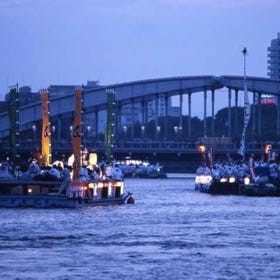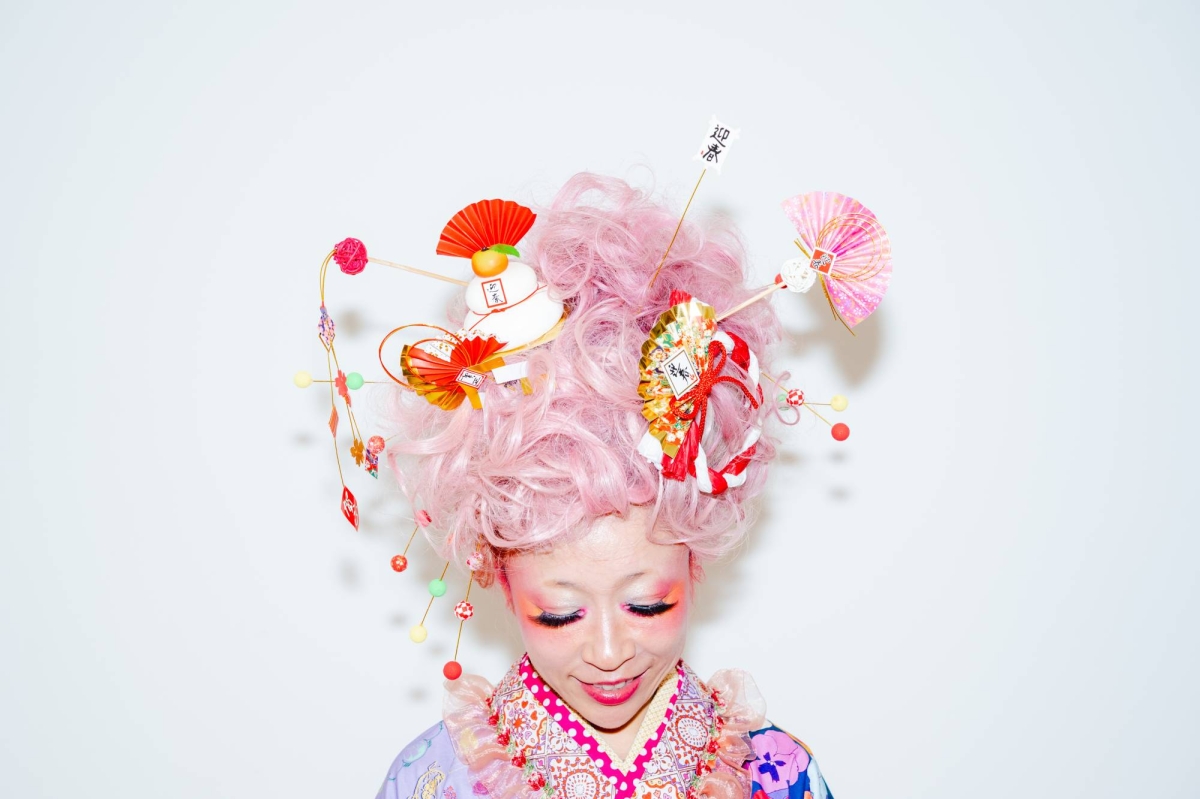Last updated: 20 May 2024
Every year, Osaka’s heart beats to the rhythm of the Tenjin Matsuri (天神祭), a grand festival that attracts 1.3 million spectators. This month-long spectacle peaks on July 25 with the Rikutogyo parade, featuring 3,000 participants, and the Funatogyo, a lantern-lit river procession on the Ōkawa River.
The night sky then comes alive with a breathtaking fireworks display, earning Tenjin Matsuri its nickname, the ‘fire and water festival.’ The popular Tenjin Festival Gal Mikoshi is another highlight, adding to the vibrant atmosphere of the festivities.
Tenjin Matsuri: Origins and Significance
Believed to have originated in 951, just two years after the Osaka Tenmangu Shrine was enshrined, the Tenjin Matsuri has earned its place as one of Japan’s three major festivals, alongside Tokyo’s Kanda Festival and Kyoto’s Gion Festival.
The annual Tenjin Festival takes place from late June to July 25, with its epicenter at the Osaka Tenmangu Shrine in Tenma, Osaka City.
The festival reaches its peak on July 24 and 25, known as Yomiya and Honmiya, respectively, attracting a significant influx of visitors.
On the 25th, be prepared to witness a truly mesmerizing sight as the sky erupts with a spectacular display of 5,000 fireworks, while a fleet of 100 boats gracefully floats along the Ōkawa River.
Getting to the Tenjin Matsuri: Access and Directions
Osaka Tenmangu is a 1-minute walk from Osaka Tenmangu Station on the JR Tozai Line.
-

-
Address
Tenjinbashi, Kita-ku, Osaka-shi, Osaka, 530-0041
View Map
-
Nearest Station
Tenjimbashisujirokuchome Station (Tanimachi Line / Sakaisuji Line / Hankyu-senri Line)
3 minutes on foot
-
Phone Number
06-6353-0025
-
Address
Tenjin Matsuri Event Schedule
The scheduled dates for the year 2024 are as follows. Please note that the venue, time, events, and other details provided are based on those of past years and are subject to change.
It is recommended to check the Tenjin Matsuri website beforehand for the most up-to-date information before visiting.
・Event Dates: July 24 – 25, 2024
・Venues: Mainly at and around Osaka Tenmangu Shrine, and others.
July 24 (Yomiya)
- 4 AM – Ichiban Taiko (First Drum, signaling the start of festivities)
- 7:45 AM – Yoimiya Festival (Eve Ceremony, a preparatory ceremony for the main festival)
- 8:30 AM – Hokonagashi Procession
- 8:50 AM – Hokonagashi Shinji (Procession and ritual involving the floating of a sacred spear)
- 11 AM – Angūsai (A ceremony conducted at a temporary shrine set up for the festival)
- 11:30 AM – Yamakage Ryūgishiki Hōchō Hōnō (A traditional knife ceremony dedicated to the gods)
- Noon – Tenjin Kōshi Lion Dance (A traditional lion dance performance in honor of the gods)
- 4 PM – Moyo-oshidaiko Jichijunkō (A procession featuring large festival drums)
- 4:15 PM – Entrance of Dondoko boats – Hokonagashi Kamikohōkan (The arrival of the Dondoko Boat and the ritual return of the sacred spear)
- 6:40 PM – Suijō Takiginoh (A traditional Noh performance held on the water)
- 7 PM – Moyo-oshidaiko (Procession featuring large festival drums)
- 7:30 PM – Lion Dance
July 25 (Honmiya)
- 1:30 PM – Honmiya Festival (The main ceremonial event of the festival)
- 2:15 PM – Shinreigyo (The movement of the divine spirit to a portable shrine for the procession)
- 3:30 PM – Departure for Rikutogyo Procession (A grand procession through the streets featuring various festival participants)
- 5:30 PM – Departure for Funatogyo Procession (A procession of boats decorated and lit up for the festival)
- 6 PM – Funatogyo (Boat Procession)
- 7:30 PM – Funajosai (On-Boat Festival)
- 7:30 PM – Fireworks (A spectacular fireworks display dedicated to the gods)
- 9 PM – Saitaiko no Miyairi Kaishi (Grand Taiko Drum Entrance Commencement)
- 10 PM – Kango-sai (The concluding ceremony of the festival, marking the return of the divine spirit to the shrine)
11 Highlights of the Tenjin Matsuri

1. Flowers of Tenjin Festival: Liven up the Tenjin Festival by Watching the Gal Mikoshi

The Gal Mikoshi is held on July 23 as a pre-event to liven up the Tenjin Festival. Originally known as the Tenjin Matsuri Jōsei Omikoshi or the Tenjin Festival Women’s Omikoshi, it became known as “Gal Mikoshi” as its popularity spread in Osaka. During this lively event, a group of eight women energetically parade the 200-kg portable shrine, known as a mikoshi, through the bustling Tenjinbashisuji Shopping Street.
2. Ichibandaiko: Signaling the start of Tenjin Festival
The event known as “Ichibandaiko” is a captivating celebration that heralds the dawn of the Tenjin Festival. At precisely 4 AM, the main gate of Osaka Tenmangu Shrine opens, marking the beginning of the festivities.
It is at this moment that the skilled performer, known as the ganji of Moyo-oshidaiko, strikes the giant ichibandaiko drum, resonating throughout the surroundings.
This energetic beat sets the stage for the lively performances of danjiri music and the captivating dragon dance. These vibrant displays come together to swiftly elevate the atmosphere of the Tenjin Festival, creating an exhilarating experience for all.
3. Hokonagashi Shinji: The ancient origin of the Tenjin Festival

To cleanse away sins and impurities, there is a ritual called “Hokonagashi Shinji” where divine children release a white wooden hoko float into the Dojimagawa River.
The “divine children,” who are selected from local elementary school students, participate in this sacred ritual of the Tenjin Festival. Throughout the festival, these boys adhere to strict customs and purify themselves. In the Hokonagashi Shinji, they play a significant role in guiding and releasing the hoko float along the river. It is a momentous responsibility they carry out with great dedication.
4. Moyo-oshidaiko Jichijunkō: Marvel at the sight of people beating the taiko drum
The “Moyo-oshidaiko Jichijunkō” is a procession where the spirited “Moyo-oshidaiko” drum takes the lead, accompanied by the energetic shouts of “Chesajaa” and “Sokojaa.”
This procession, a prominent feature of the Tenjin Festival, involves the Moyo-oshidaiko drum being vigorously played while marching. Alongside the rhythmic beats of the drum, the lion dance of the Tenjin Kōshi Shishi parades in unison. It is a dynamic spectacle where the Moyo-oshidaiko drum and the captivating lion dance come together to create an enthralling experience for all.
5. Suijo Takigi-Noh: A performance above water
One of the stage boats used for the “Funatogyo” river procession during the Tenjin Festival is the “Nohbune” (Noh boat), which is moored at OAP Harbor. Onboard this boat, a unique performance called “Suijo Takiginoh” (Waterborne Torchlight Noh) takes place.
This mesmerizing spectacle showcases Noh performances conducted on the water. The event also features attention-grabbing musical accompaniments by the Osaka Tenmangu Shrine Religious Society Federation, as well as the lively “Dondoko Funabune” procession.
It’s an experience that captures the essence of the festival, where traditional arts and vibrant festivities blend together.
6. Honmiya Festival: A prayer for peace and prosperity in Osaka
The “Honmiya Festival” is conducted in the morning within the precincts of the Tenmangu Shrine. As the resounding beats of the Moyo-oshidaiko drum and the lively music of the floats cease, the festival is solemnly held to pray for peace and prosperity in the city, warding off disasters and epidemics. Once this sacred ritual begins, people start to gather and join the procession, symbolizing their participation in the divine journey.
7. Rikutogyo: A large procession comprised of 3,000 people

Rikutogyo
The “Rikutogyo” procession is a majestic spectacle where approximately 3,000 participants, adorned in splendid attire, march in a parade from Osaka Tenmangu Shrine to the boat landing. This land procession, known as “Rikutogyo,” presents a dazzling scene reminiscent of a vibrant and elegant historical scroll painting. The participants, dressed in colorful costumes and carrying sacred objects, offer their presence as a procession to the gods. At the forefront, the remarkable sight of the lead “Moyo-oshidaiko” drum, played by a group of three performers called “ganji,” who strike the drum with rhythmic beats and spirited shouts, is an absolute must-see!
8. Funatogyo: Watch as more than 100 ships slowly traverse Okawa River

After completing the land procession, the procession arrives at the boat landing area located near Tenjimbashi. One by one, participants board the boats starting from the Moyo-oshidaiko, and they set sail into the Okawa River, commencing the “Funatogyo” boat procession.
The procession includes various types of boats that contribute to the festivity. These include the “Gohoren Houansen,” a boat carrying the divine spirit of the deity; the “Kumihososen,” carrying the Moyo-oshidaiko drum and floats; the “Omukae-bune,” adorned with elegant dolls to welcome the divine spirit; and the “Houbai-bune,” boats representing corporations and organizations paying their respects. In addition, there are other miscellaneous boats, such as the “Dondoko-bune,” freely navigating the procession, adding to the vibrant atmosphere of the festival. As the dedicated fireworks illuminate the night sky, the blossoming lights blend harmoniously with the shimmering water, creating a captivating display.
9. Funatogo Senjosai: A solemn ritual aboard Funatogyo boats
During the boat procession, a solemn ritual called the “Funatogyo Senjo-sai” takes place on the ceremonial boat. This ritual serves as an opportunity for the deity to observe the lives of the local worshippers and citizens from the vessel and bestow divine protection upon them. As the boat ritual unfolds, other boats passing by the ceremonial boat traditionally pause their lively music temporarily and respectfully offer a silent farewell. This gesture of quiet reverence has become a customary practice.
10. Fireworks: Marvel at the festival finale as it lights up the night sky and river waters

The fireworks are the finale of the Tenjin Festival. Marvel at the majestic scenery of fireworks lighting up the night sky of Ōsaka and the brazier fires on the 100 boats of the Funatogyo. Four thousand rounds of fireworks shoot up from Kawasaki Park and Sakuranomiya Park. You should also see the kōbai, an original firework which blooms into the shape of an umebachi or plum bowl associated with Tenjin-sama – the deified spirit of Sugawara no Michizane!
11. Watch from special seats with a great view of the fireworks!

The finale of the Tenjin Festival is marked by the spectacular fireworks display. These dedicated fireworks create a mesmerizing spectacle, illuminating the night sky of Osaka along with the mystical “Kagaribi” (bonfires) of around 100 boats participating in the boat procession. Approximately 4,000 fireworks are offered from two locations, Kawasaki Park and Sakuramiya Park, creating an enchanting scene. Among them is the breathtaking beauty of the original firework called “Koubai,” which opens up in the shape of a plum blossom, symbolizing the deity “Tenjin.” It is a must-see display of radiant colors and artistry.
How crowded is the Tenjin Festival? What are the things to remember during the festival?
If you’re planning to watch the dedicated fireworks display, it’s best to avoid using JR Sakuranomiya Station as it tends to get extremely crowded before and after the viewing.
Instead, consider walking from JR Osaka Tenmangu Station, Subway Minamimorimachi Station, or JR Kyobashi Station, which are closer to Osaka Tenmangu Shrine. This way, you can avoid some of the congestion. For a more comfortable viewing experience, it’s advisable to purchase tickets for the reserved seating area in advance.
After the impressive Rikutogyo land procession, the traditional boat procession, and the bonfires lighting up the grand fleet, the festival reaches its climax as approximately 5,000 dedicated fireworks burst into the night sky! Just on July 24th and 25th alone, there are plenty of magnificent, vibrant, and enchanting highlights to see.
So, make sure to check the schedule for the parts you want to witness and head to the festival grounds. It’s going to be an extraordinary experience!
Text by: Efeel Inc.
*The above article was originally published in June 2020 and updated in May 2024.
*This information is from the time of this article’s publication.
*Prices and options mentioned are subject to change.
*Unless stated otherwise, all prices include tax.






















Discussion about this post